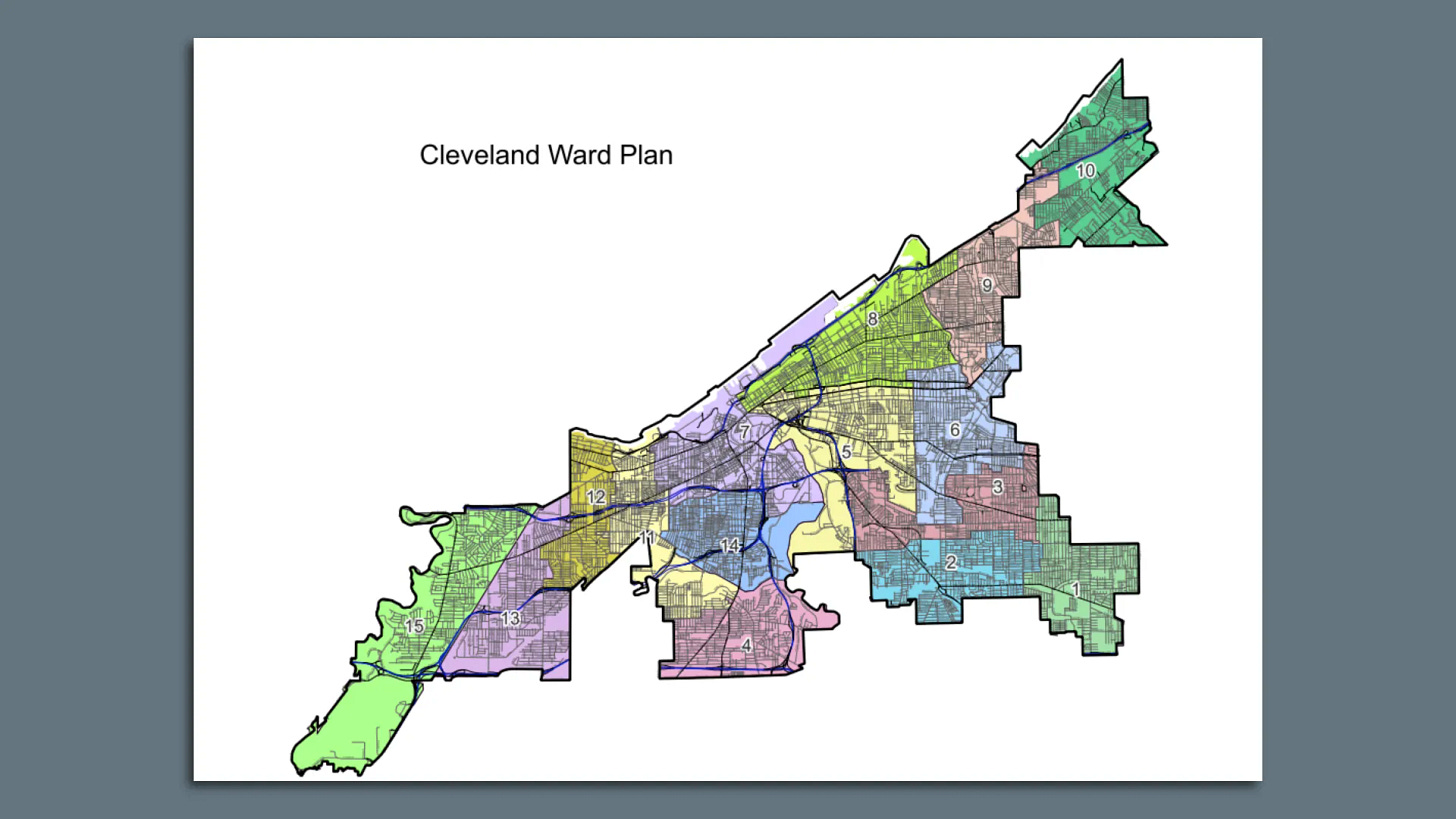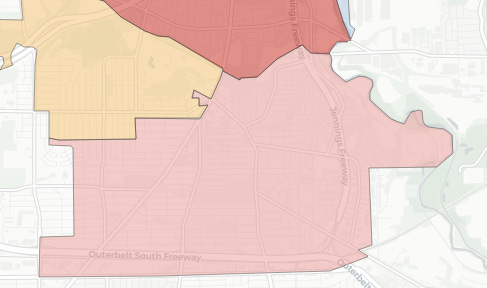Blaine's Gerrymandered City
In a notoriously gerrymandered state, you'd think a major blue city would balk at gerrymandering itself on principle. Apparently that's not the case.
On December 10, 2024, Cleveland City Council President Blaine Griffin unveiled a map to re-apportion Cleveland’s wards and reduce the seats on Council from 17 to 15. This comes after Ward 12 Councilwoman Rebecca Maurer called out the backroom dealings of Blaine and his cadre, leading to the gerrymandered wards. It’s clear that infighting within the Democratic Party and Cleveland elites have decided against free and fair elections, and the new map reflects this. Let’s talk about it.
Cleveland is Still a City in Decline
This city was once the bastion of hope and prosperity seated squarely on the Great Lakes and serving as home to America’s new industrial aristocratic class. Now, Cleveland competes with Detroit for the poorest American city, facing infrastructural decay leading to a continued white flight, poverty as the norm for residents, and daily violent crime. The GOP are notorious for sowing social unrest by lying about the state of American cities, but the City of Cleveland is one of few where the national trends aren’t fully reflected in the lived realities of residents, and things keep getting worse.
As if these issues weren’t enough, our public officials are intent on continuing to line the pockets of absentee billionaires by investing in luxury Downtown development projects that are inaccessible to everyday Clevelanders, reap investment returns for the despicably wealthy, and cost taxpayers billions ad infinitum. Cleveland’s history is the history of organized crime and political machines, and things are much the same.
With this all having been said, the reality of Cleveland’s situation, based on the charter as it stands today, is that we must reduce the seats on Council from 17 to 15. This, of course, means that Clevelanders will be less accurately represented, and same Clevelanders may have their voting power diminished relative to others who would stand to benefit from re-apportioned wards. Political representation is imperfect, and Cleveland’s charter is far from a utopian document—this is just the way things are.
So What is Blaine’s Plan?
In short, nothing good.

There is no doubt that the current wards are gerrymandered, and this part of Blaine’s narrative is true. It’s also true that the current wards are nonsensical and don’t clearly align with natural or human-made boundaries that already exist throughout Cleveland. This is a city of many diverse neighborhoods that were formed prior to annexation and took on a new civic identity when they were ceded to Cleveland. One would hope that our representation would reflect this history. Of course, it doesn’t.

Clearly, the proposed wards are a marginal improvement in some respects. First, the proposed map reduces the amount of elongated and circuitous wards that are obvious artifacts of gerrymandering. Second, it more closely aligns with Cleveland’s natural neighborhood boundaries, whereas the current wards largely disregard them. And third, the proposed map more closely aligns with the present state of city-wide development projects—regardless of their merit—aligning representation to the situation on the ground. Nevertheless, the proposed map falls short in greater ways.
Gerrymandering . . . but Creatively.
While there are parts of the proposed map that make sense, there are many, many, many more that don’t. And where they don’t lies gerrymandering.
Wards 11 and 12
This is a prime example of the proposed map succeeding in one way and massively failing in another. Take the proposed wards 11 (orange) and 12 (green).

Does this border make sense to you? Is there a clear natural boundary separating these two wards? Is it truly the case that people further south have more in common with those to their north than they do to their neighbors to east/west?
No.
In fact, an obvious natural boundary exists with the highway lying horizontally across the wards. This is where the previous boundaries were drawn, but the proposed map disregards this natural boundary entirely in favor of vertical plinths.
Wards 4 and 11
A similar situation presents itself with the proposed wards 4 (pink) and 11 (orange).

Old Brooklyn is one of few neighborhoods in the City of Cleveland that has a strong, decisive, and unambiguous natural boundary separating it from the rest of the city.
This is the Brookside Valley Reservation and the Big Creek Reservation, both of which are properties protected and administered by the Cleveland Metroparks. You might not see it from the aerial view, but this valley really is a valley, and the only way to get across it to enter into the rest of Cleveland is by one of a few bridges. This valley is home to a historic—overgrown—baseball field and the Cleveland Metroparks Zoo.

It made no sense to divide Old Brooklyn into Wards 12 and 13 with the present map, and it makes even less sense to do so with the Brookside area. This is another indication of gerrymandering because of who might live in that area (nudge nudge).
Wards 5, 7, and 8
A third example of gerrymandering is with the proposed wards 5, 7, and 8.

This may be a controversial opinion, but it doesn’t make much sense for wards to cross the Cuyahoga River. The divide between the east and the west of Cleveland is the history of slavery in the north, but the river is as hard a boundary as any. Further, what does Downtown have in common with residential parts of Tremont and Ohio City? Sure, there’s some commonality in the entertainment and commercial districts, but those don’t represent all of the neighborhoods.
Who’s interests would this councilperson represent?
The East Side
What’s proposed for the west side is controversial—but the east side is much worse.

There are many problems with these wards. First, what’s the logic behind how they were drawn? You can clearly see natural boundaries scattered all throughout the east side—and this is just the human-made ones, ignoring the geographical distinctions and historic neighborhoods. Does the map align with these? Absolutely not.
In fact, there are obvious artifacts of gerrymandering throughout these wards, where a boundary suddenly juts in one direction when there was a seemingly logical path in another. When these occur, they almost always reflect major landmarks that were likely points of negotiation among councilpersons as they plotted to divvy up the city. Some examples are Cleveland State University, University Circle, and the entire Midtown development area and Health Tech Corridor.
What is to be Done?
First and foremost, Cleveland needs a new City Charter that provides for strategic reforms to Section 25-1, governing the re-apportionment of the wards. There must be guardrails put in place to prevent gerrymandering. Further, there must be resident control over the process and limitation of interference by Council. With this, there must be rules put in place establishing how wards should be drawn, what the priorities are for re-apportioning the wards, and what practices are impermissible, to prevent political warfare among councilmembers, as per today.
Second, political representation and opportunities for community development must be extended to the neighborhoods, as chief parts of the story of this city. The neighborhoods are the lifeblood of Cleveland, and many Clevelanders identify with their resident neighborhood before they will with the city itself. If implemented correctly, we can preserve the historical communities that built this city, provide for neighborhood-level opportunities for all Clevelanders, and rebuild from the ground up, as opposed to Downtown out.
Finally, we must put an end to the corporate ownership of this city. While Cleveland was built and continues to live on the backs of everyday Americans, corporate oligarchs past and present have a stranglehold on politics and local reforms. Just like Eliot Ness ushered in a new era for Cleveland in the 30s, so too must we usher in a second era of reform that cleans up the legalized forms of organized crime that plague the everyday lives of everyday Clevelanders.
Only then can we become a city of lights, a city of magic—without ecological disaster.
Subscribe now for Ohio hot takes from the left. Visit our website for more info at neoleft.org. Keep up with our social media antics on Twitter and TikTok.




